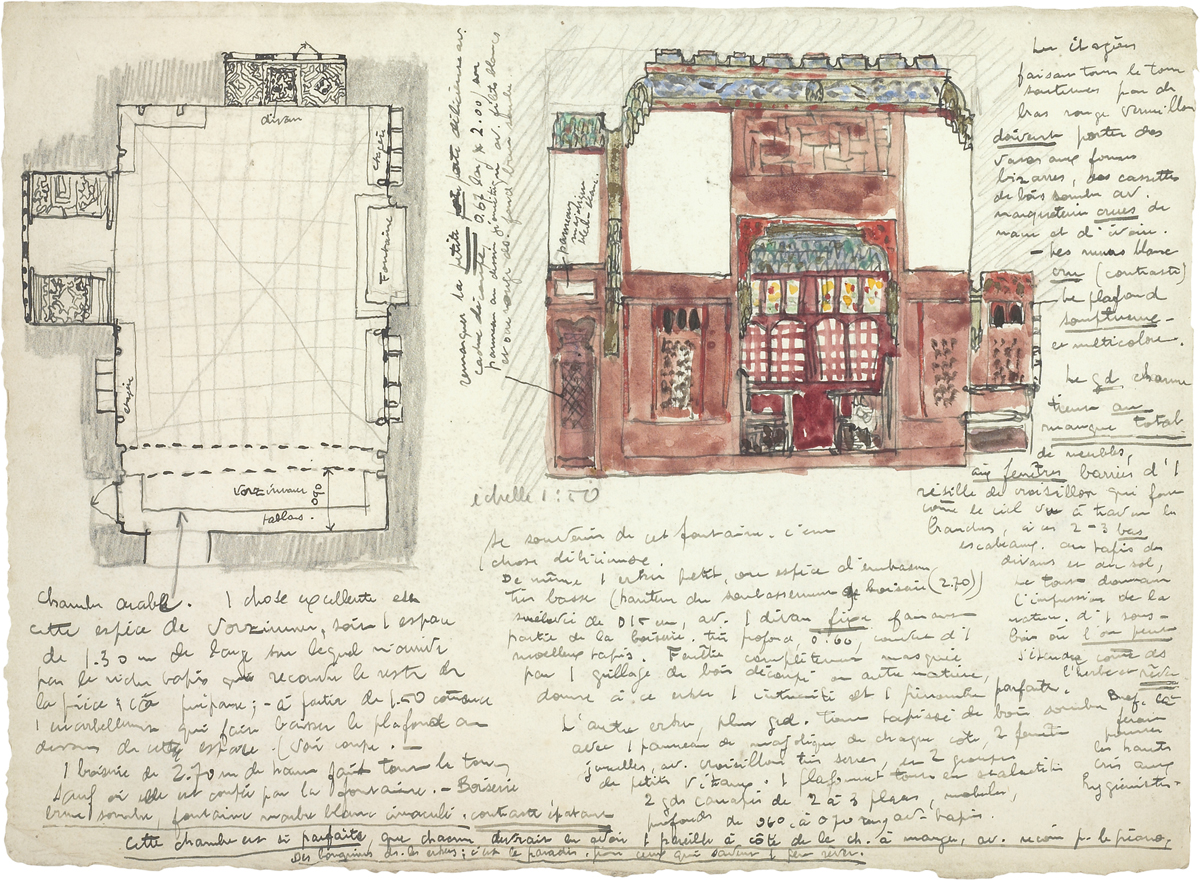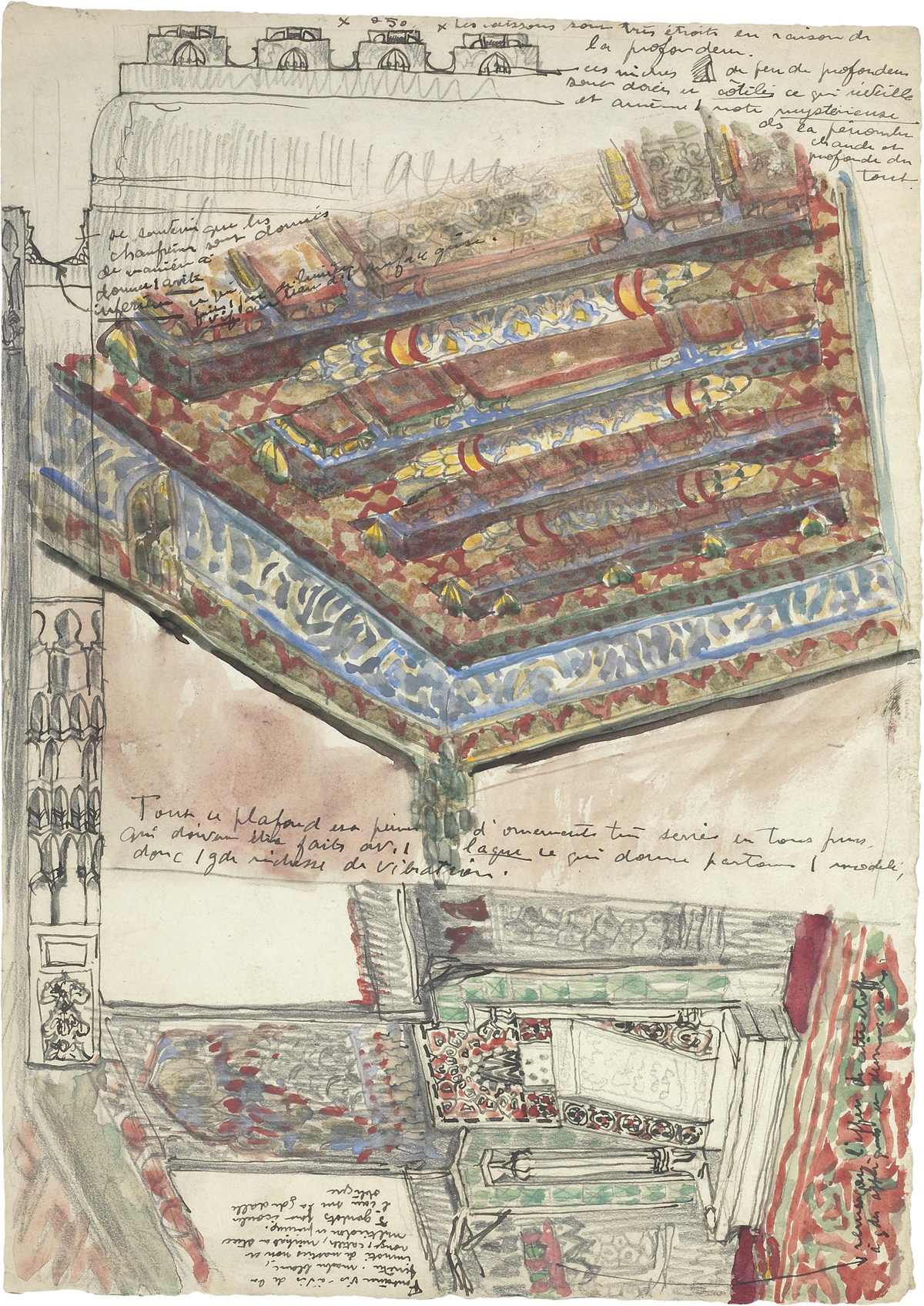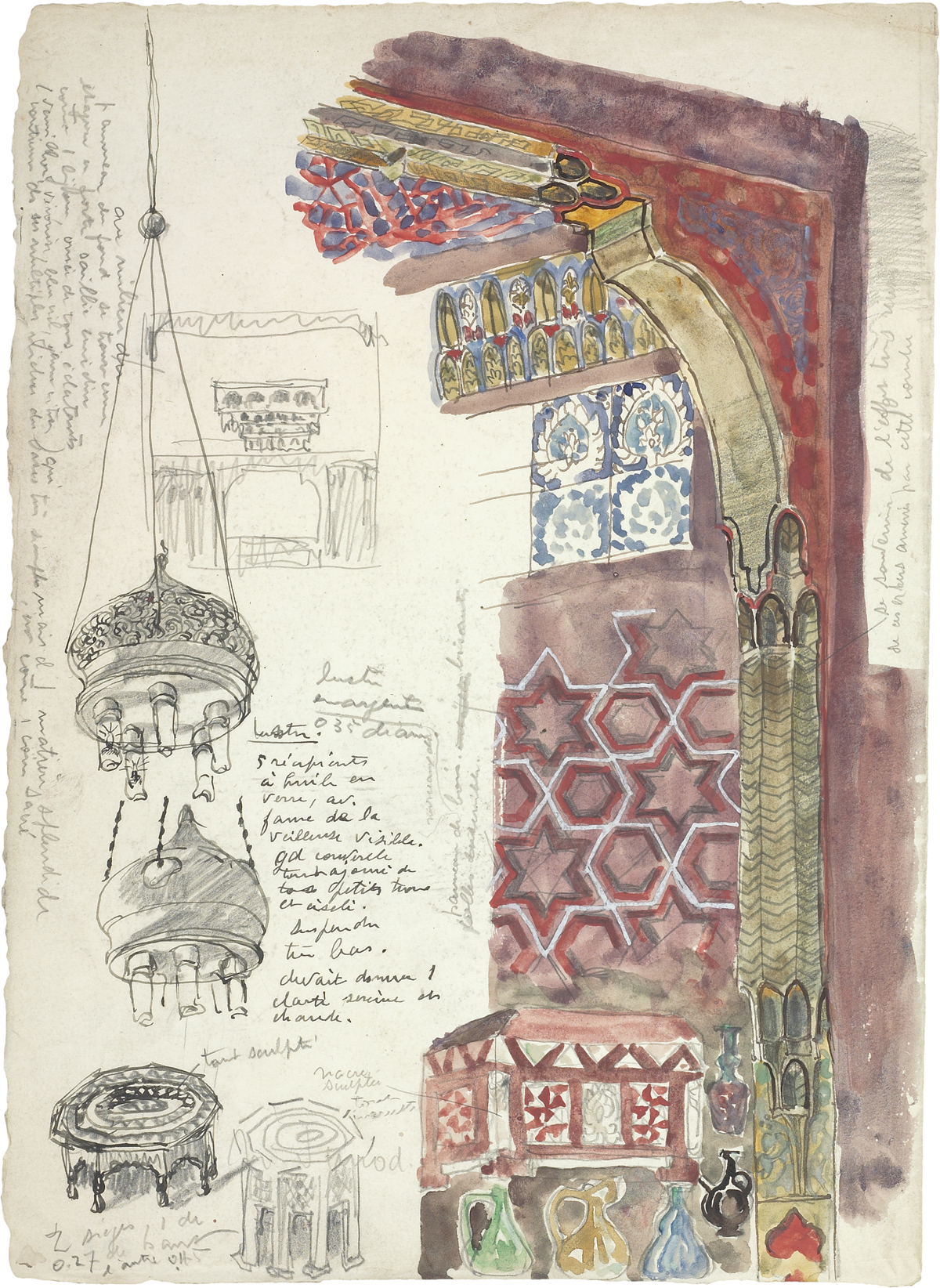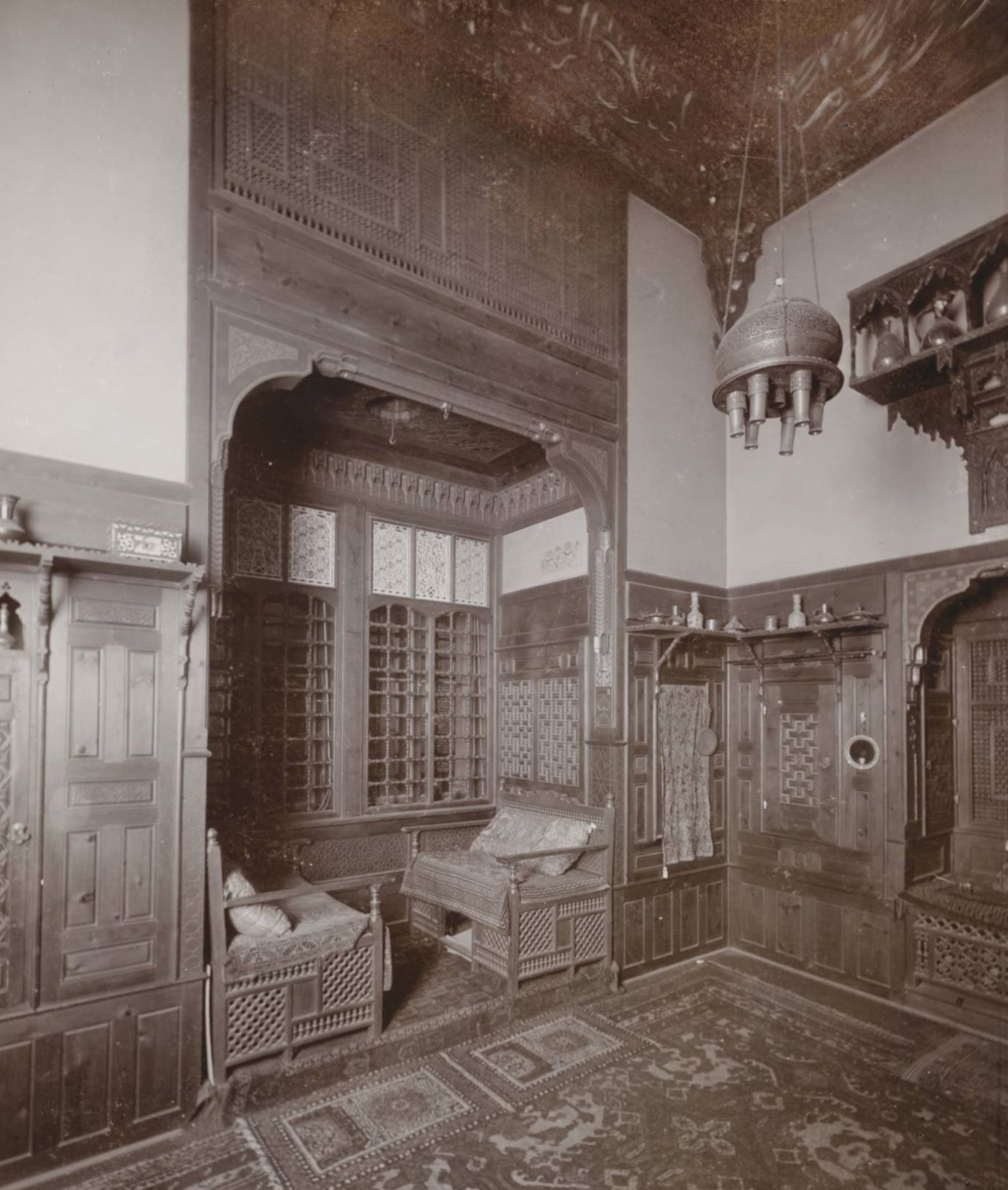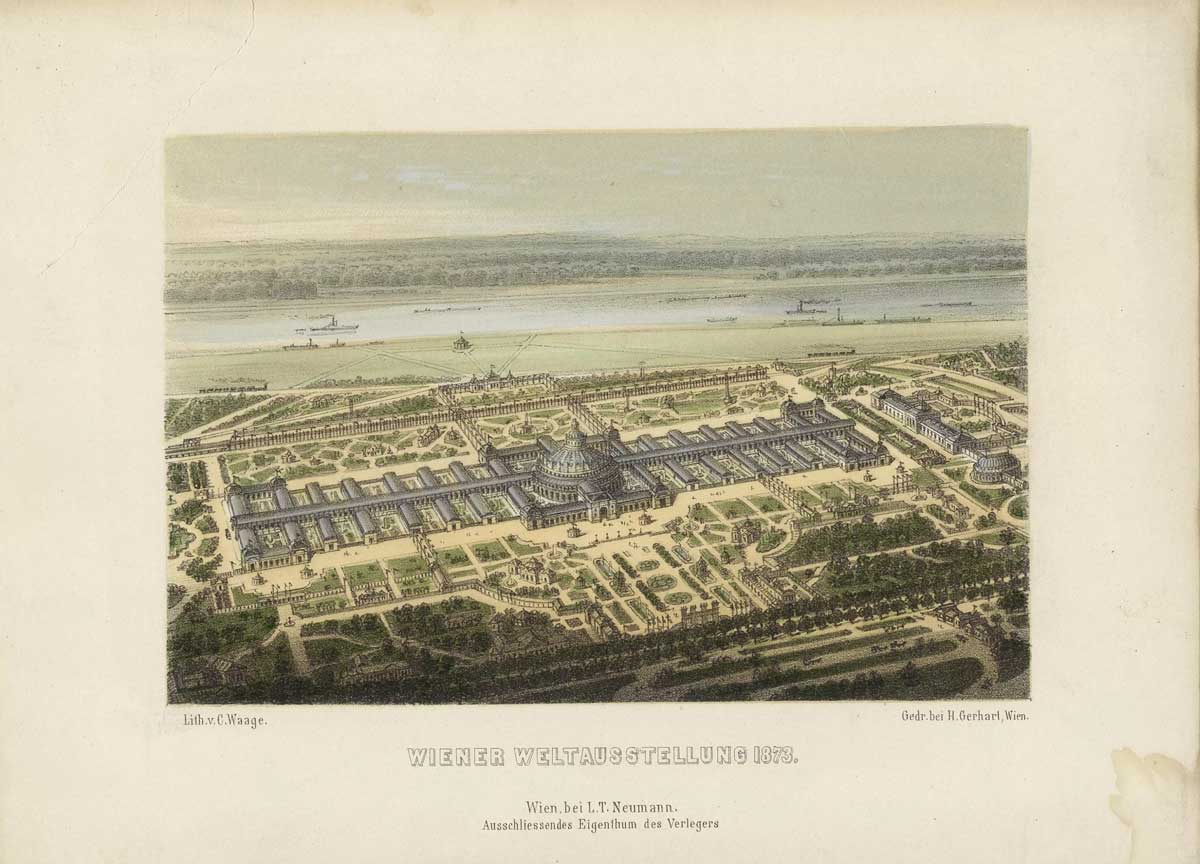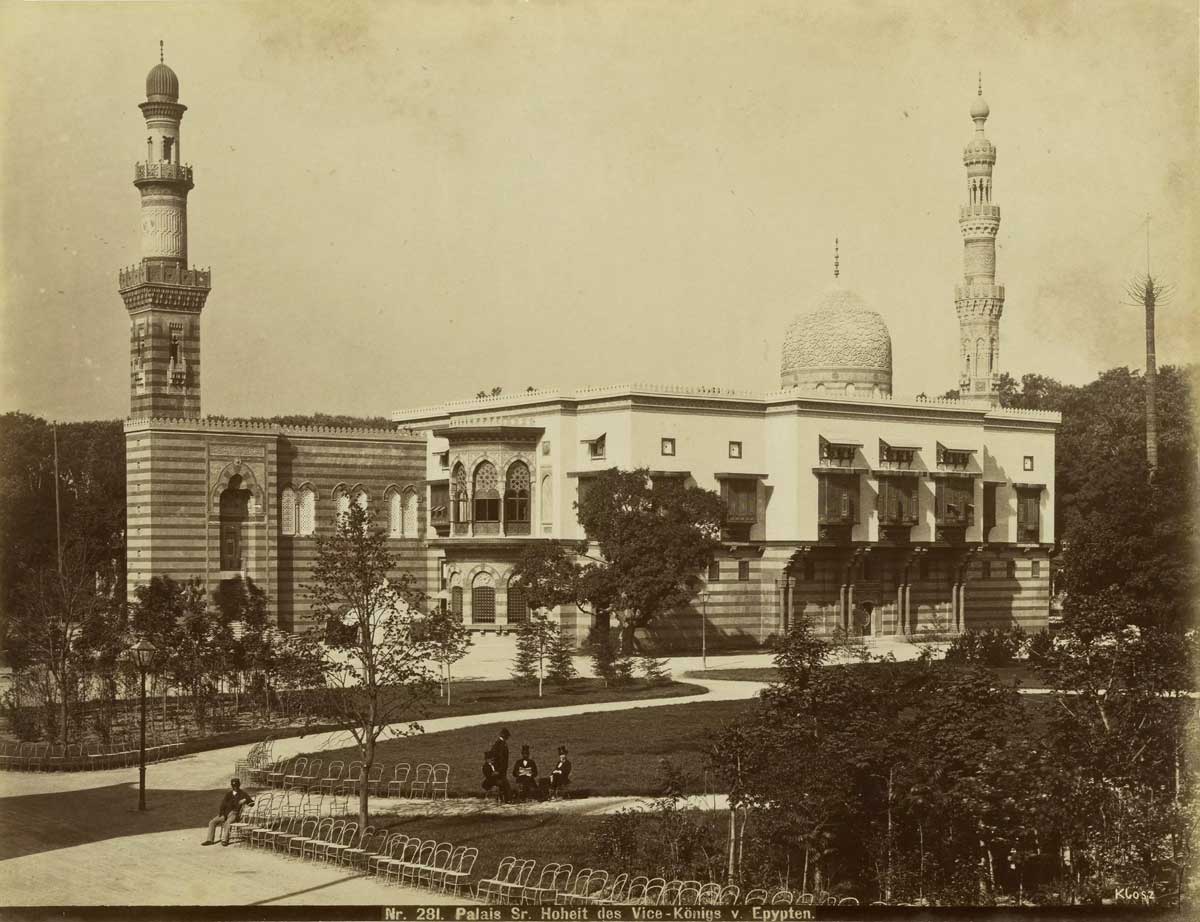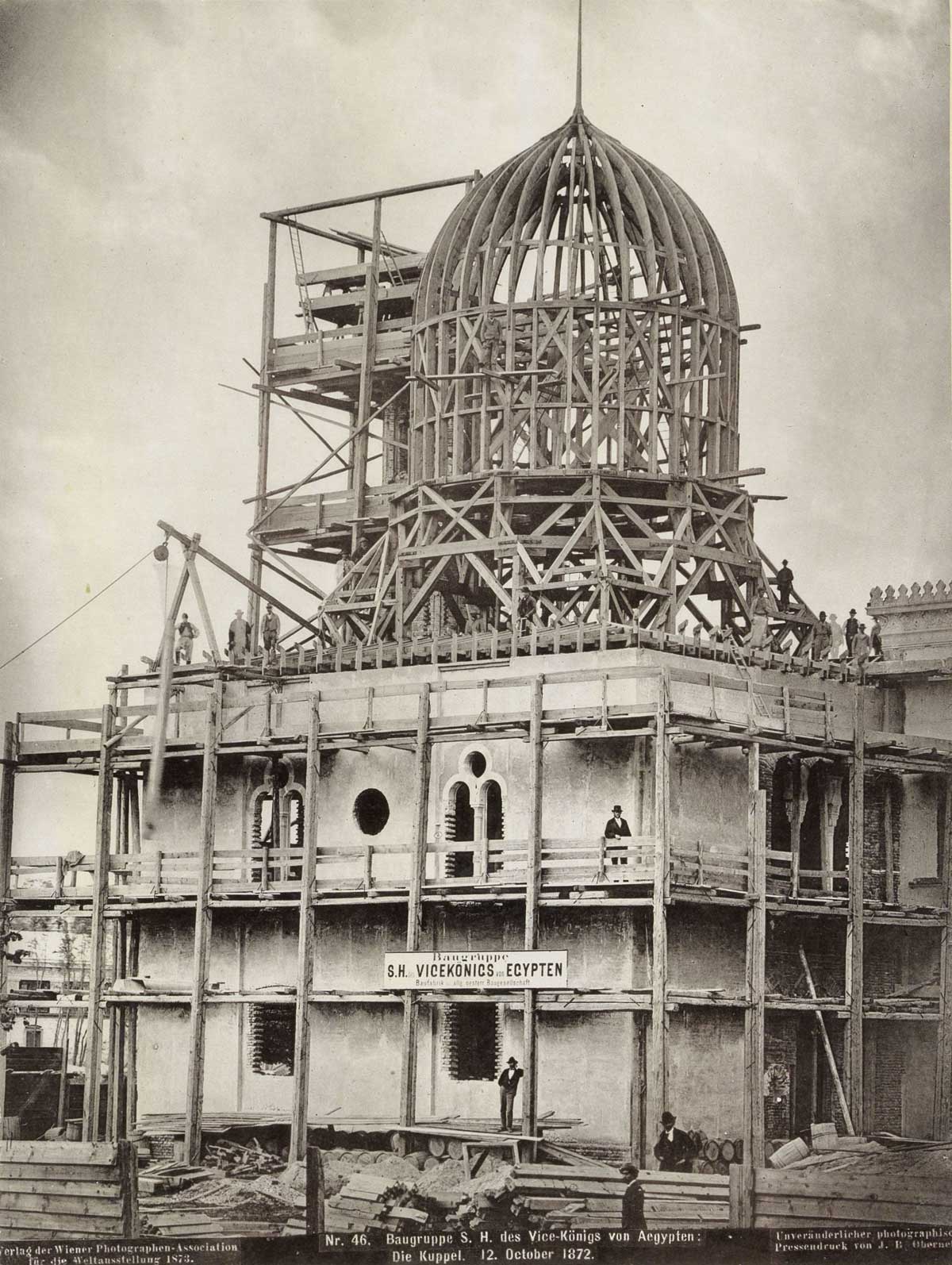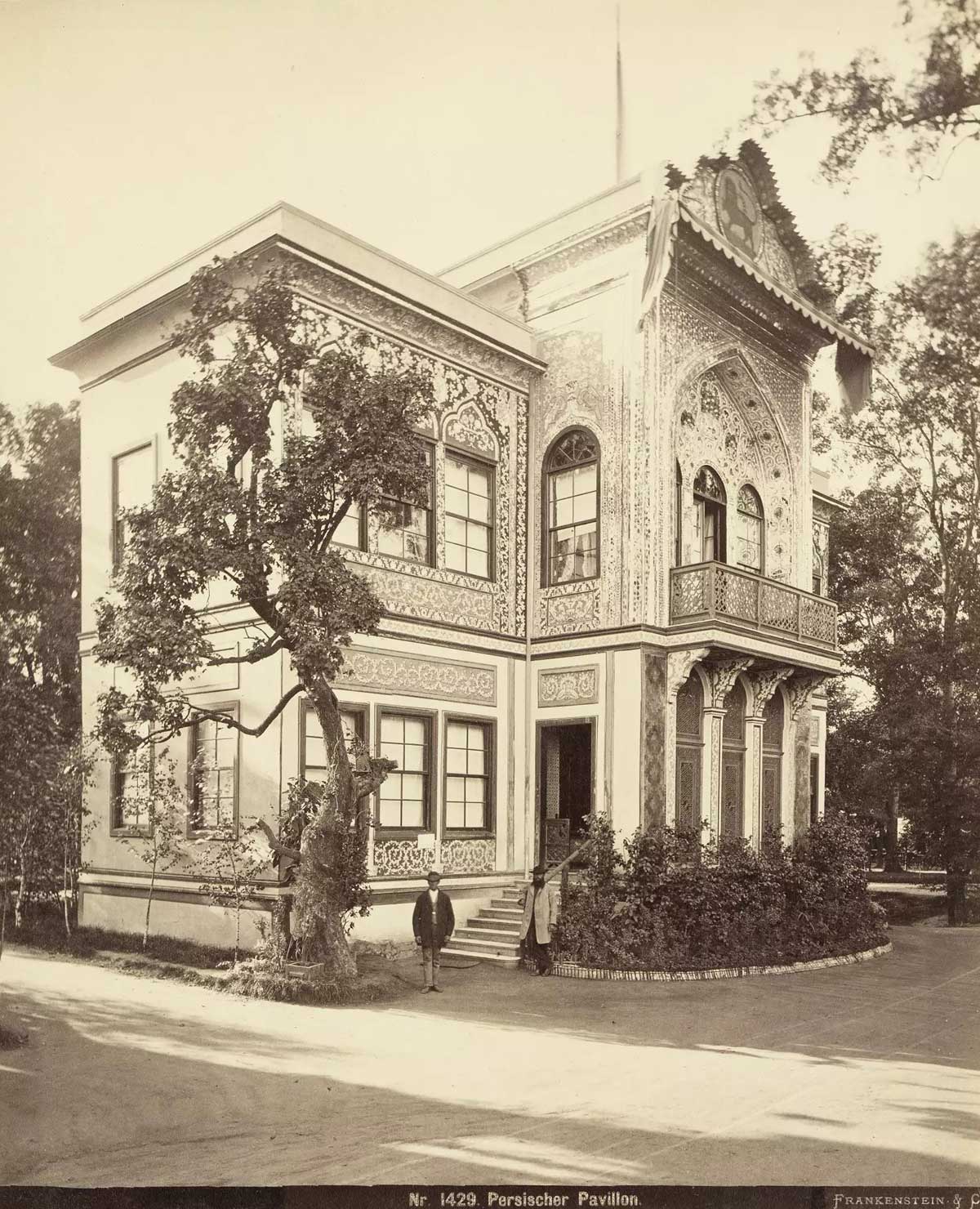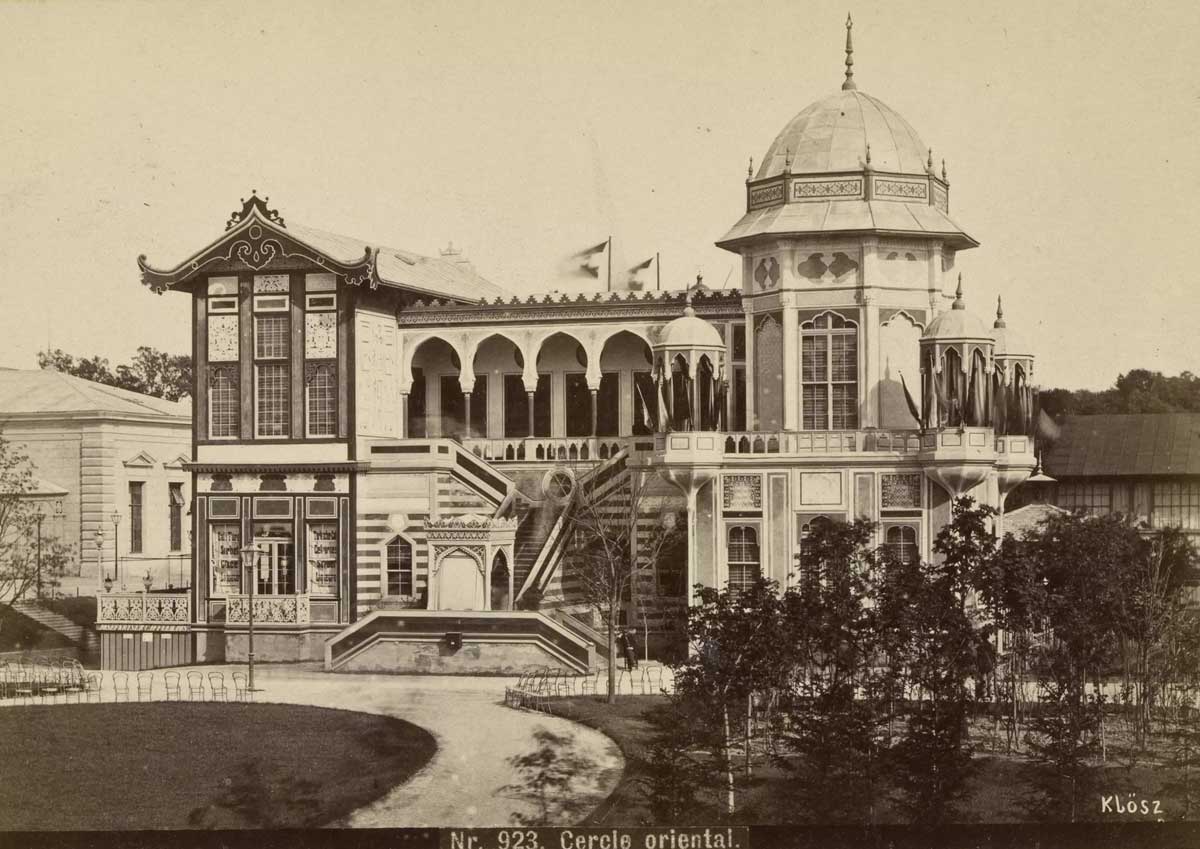Introduction
In a letter dated 2 March 1908 that Le Corbusier wrote to his decorative arts teacher, Charles L’Eplattenier, the former recounts a visit to the Imperial Royal Austrian Museum of Art and Industry in Vienna and describes the considerable impression the aesthetic quality of the Arab Room, which the museum had opened in 1883, had made on him: ‘There I saw a completely furnished Moorish room, which in terms of its layout, comfort, light, as well as its beauty and universal principles, is worth more than lectures from any school’ (2002: 51). During his visit to the museum, Le Corbusier made sketches with precise descriptions to recollect the arrangement of spatial components that he hoped captured the logic of the captivating ‘oriental’ atmosphere of the chamber (May Sekler 2000: 253). He produced a floor plan with dimensions, a front view of the left wall as seen from the entrance (Figure 1), the paneled ceiling (Figure 2), and details of the alcoves and furnishings such as lamps and small gueridons (Figure 3). The wooden latticework covering the windows (mashrabiya), as his notes reveal, induced an intimate and ‘mysterious dimness’ (1908a). The divans in the alcoves, covered with oriental carpets, created ‘a paradise for those knowing how to indulge in dreams’ (1908c). Additional details in the sketch show a small wall fountain (faskieh) and a silver, cupola-shaped pendant with five glass oil lamps that Le Corbusier states suffused the room with a ‘warm and peaceful brightness’ (1908b). Every piece of furniture — seats, tables, storage — was integrated into the walls so that the Smyrna carpet, covering the entire floor of the chamber, could have the most effect. ‘The room was so perfectly made,’ Le Corbusier exclaims in his notes, adding ‘everyone should have something like it next to their dining room’ (1908b).
The interior decoration responsible for what Le Corbusier saw as the room’s enchanting and perfect oriental spatial qualities was, however, in many ways an Austrian industrial product. It had been assembled by the Austrian architects Franz Schmoranz and Jan Machytka and featured a wild mix of oriental samples of different stylistic origin, samples that had largely been designed and manufactured in Austria (Figure 4). Only some decorative objects which were part of Schmoranz’s private collection were of Arabic origin (Schmoranz 1876: 126). Le Corbusier was thus looking at an Orient made in Austria, learning from oriental typologies that displayed the design and manufacturing skills of the monarchy’s own industries. The creation of the sort of oriental(ist) architecture and crafted objects that Le Corbusier wanted to acquire highlights a process of cultural appropriation that was inevitably linked and coordinated with the modern practices of fabrication and commercial dissemination of industrial products.
Arab Room, designed by the Bohemian-Austrian architects Franz Schmoranz and Jan Machytka, on display at the Imperial Royal Austrian Museum of Art and Industry from 1883 to 1931, MAK, Vienna, Inventarnummer KI 7266-1. © MAK https://sammlung.mak.at/sammlung_online?id=collect-167597.
In Austria, this fascination with constructing oriental interiors at the end of the 19th century that enabled Europeans to step into the Orient without having to travel to faraway lands was fed by the exhibits of the 1873 Vienna World’s Fair. Its displays constituted ‘the peak of Oriental-Islamic exhibitions in 1873’ (Al-Madhi 1973: 4f), highlighting the three-dimensional rooms that people could walk through that popularized oriental architecture and interiors in the second half of the 19th century. This trend also fueled the industrial production of orientalized decorative objects, most famously the decorative enameled glassware in Persian and Arabic décor produced by J. & L. Lobmeyr, the first industrial glass manufacturer to apply the Islamic techniques of Mamluk Egypt and Syria to glassware. The company’s orientalist designs also found their way into the Austrian collection at the 1878 World’s Fair in Paris.
This paper argues that the architectural representations of the Orient at the Vienna World’s Fair drew on assemblage, articulated through a capitalizing of oriental form, figure, and architectural elements in an exhibitionary context, to advance the Austrian monarchy’s economic and colonial trade policy. The cultural appropriation of the Orient1 results in the construction of seemingly oriental buildings that generate a new form of colonial economy for Austria-Hungary. We approach the orientalist architecture on display at the Vienna World’s Fair from the perspective of critical studies in architecture, aiming to uncover the cultural and economic factors that informed its design as well as its effects on different discourses and ideological systems (postcolonialism, imperial trade politics, or exhibition culture).
Our view of orientalist buildings is grounded in previous studies that analyze orientalist architectural representations in the context of world fairs from a cultural and multidisciplinary point of view rather than guided by an approach that treats them as a product of ‘imaginative appropriation’ (Koppelkamm 2015). Examples of the former include Zeynep Çelik’s Displaying the Orient, an important survey on the Islamic quarters of 19th-century world exhibitions, Timothy Mitchell’s ‘Orientalism and the Exhibitionary Order’ (1992), which identifies orientalism as a strategy of an imperialist/colonialist representational order of the Western world, and Ithoan Osayimwese’s crucial study Colonialism and Modern Architecture in Germany (2017), which examines the nexus between architecture and colonialism through the lens of cultural politics and global relations. This essay widens the focus of these studies by exploring Austria’s exhibitionary strategy and especially the buildings of the Oriental Quarter of the Vienna Fair, thoroughly documented and analyzed by art historian Jutta Pemsel in her 1989 Die Wiener Weltausstellung von 1873 (The Vienna World’s Fair of 1873), from the perspective of postcolonial trade politics.
The Austrian monarchy’s integration of the Orient into a network of trade relations by the third quarter of the 19th century is reflected in how the Vienna World’s Fair was organized, how its (orientalist) architectural ensembles were designed and constructed, and finally, how they were sensually experienced by the visiting public. This larger process of instrumentalizing the Orient was realized at all scale levels, from the ornamental figure to urban agglomeration, thus rendering it a projective international enterprise. While the architectural representations of the colonial expansion of other European countries were informed by acquired knowledge of a conquered terrain, the architectural display of the economic expansion practiced by the Habsburg Empire was grounded in its own domestic industry, through which its manufacturers were familiarized with oriental products so that they could then promote distributive trades and global commerce. Bernhard Singer’s 1878 publication on Austria’s trading interests with the Orient, entitled Unsere Orient-Interessen (Our interests in the Orient), confirms it was the colonial economy rather than territorial interests which led Austria to construct and display the Orient on a grand scale. ‘The conquest of the Orient as a sales region’, as Franz Seraph Griesmayr has argued, was ‘the slogan and the magic key for the export trade’. Places such as the Balkan Peninsula and the Near East were regarded as perfect ‘sale territories’, places where the ‘industrial production of the Austro-Hungarian Monarchy could be commercialized’ (1968: 5f). The construction or building of the Orient in architectural terms played a critical role in this colonial economic strategy, as the Vienna’s World Fair suggests.
At the fair, the Orient — widely understood to be a social-constructivist, intellectual product of Western orientalism and economic interests — manifested itself in physical form and by means of architecture in two distinct displays: that of products in the exhibition’s industrial main hall and that of built representations of orientalist architecture in the Eastern section of the exhibition grounds. These two interdependent forms made the Orient perceptible in spatial and architectural terms, which in turn made the Orient available for the industrial economy of European nation-states.
AustrOrient: Vienna World’s Fair, 1873
On an area of 17 hectares located in Prater Park, Vienna displayed itself as the center of global trade, represented by an impressive hall, the Industrial Palace (Industrie-Palast), which accommodated the industrial fair and featured the world’s biggest domed structure of its time in its center, the Rotunda (Rotunde). In the Industrial Palace (Figure 5), 35 nations were put on display in an architectural typology that Ludwig Klasen termed a ‘fishbone system’ (1887: 975), consisting of a nave and multiple transepts identical in form. It was organized in a strict geographical order from east to west, and the oriental nations were assigned to the eastern parts of the main hall. This formal setup met two main functional needs: first, to make orientation through the vast hall easier for its visitors, and second, to provide constant illumination of the display spaces in each transept (Krasny 2010: 42). Austria-Hungary occupied the front sections devoted to Eastern countries next to the domed central section and the exhibitions of Russia, Greece, Egypt, Persia and Turkey, with China, Japan, and Siam marked the northern edge.
Carl Libra, view of the Industrial Palace, Wien Museum, Vienna, Inventarnummer 60231. https://sammlung.wienmuseum.at/objekt/472613-bez-wiener-weltausstellung-1873/.
What distinguished the Vienna World’s Fair from previous world expositions was its programmatic focus on global trade with the East. While the grand exhibitions in Paris (1867) and London (1862) focused on the portrayal of technological innovations and manufactured products in an effort to showcase their nations as leading colonial and industrial powers, Vienna’s exhibition concept concentrated on ‘the distribution of manufactured goods’ and ‘their exchange from one country to another’ (Kalchberg 1873: 3).
The participation of the Orient at the Vienna World’s Fair — understood then as the region spanning from North Africa to East Asia — was primarily designed to promote and further strengthen trade connections made possible through the new maritime access to the Red Sea after the opening of the Suez Canal in 1869. One of the leading figures in this project was Josef von Schwegel, a graduate from Vienna’s Oriental Academy (Orientalische Akademie), who during the 1860s served as the Austrian consul in Alexandria and who had been instrumental in the establishment of consular relations when the Suez Canal opened. In order to facilitate the exchange of trade goods and information upon which the exhibition program would be built, he established exposition committees in Alexandria, Constantinople, and other consular branches in Istanbul, Smyrna, and Beirut (Rozman 2007: 193, 231).
The galleries of the oriental nations provided a broad selection of oriental export products from Egypt, Tunisia, Morocco, Persia, Siam, China, and Japan that were new and unknown to the markets of the West, such as unwrought goods, gemstones, agricultural imports, and craftworks. Among them were marble, carpets, wild silk, mohair, daggers, opium, and begging bowls from Persia and musical instruments, chiseled vessels, ostrich feathers, almonds, and a live gazelle from Morocco. The countries of East Asia mostly displayed small-scale objects such as wooden furniture, lacquer ware, porcelain, textiles, metal works, papers, and so on — in total, more than 2,300 industrial art products and commercial goods (Wieninger 2012: 150). The Chinese exhibition — consisting mainly of raw materials and industrial products — was made possible through the initiative of the Austrian consul general, Gustav Ritter von Overbeck, based in Hong Kong. China had declined to officially participate in the fair. As a result, the Italian-born Ottoman Levantine architect and decorator Pietro Montani was commissioned to design a Chinese tea pavilion — a structure completely financed by the Austrian Emil Hardt and actually modeled after a Chinese fishing cottage (Weller 1873: 7).
The Japanese government, on the other hand, was happy to participate and promote the export of traditional and decorative artworks such as ceramics, cloisonné ware, and textiles. Egypt contributed to the national gallery with export goods such as petroleum, sea salt, tobacco, ornamental plants, paper samples, cereals, olives, and gardening tools as well as production statistics, texts documenting prizes their goods had won during the fair, maps, and Arabic literary works. The Egypt section also included products from European exhibitors based in Egypt, who put printing proofs and lithographic works on display (Officieller General-Catalog 1873: 745–50). The oriental works were deemed ‘the most significant achievements of the great exhibition’ (Lessing 1874: 23) and were carefully evaluated for industrial and commercial usability as ‘the belief gained acceptance that not only the Orient could learn from the Occident but that also the latter was able to learn a lot from the former’ (Oncken qtd. in Krasny 2010: 43). For this purpose, Schwegel created the Committee for the Orient and East Asia (Comité für den Orient und Ost-Asien) and put it in charge of examining goods for their suitability for trade and initiating new trade relationships.
His curatorial strategy involved not only the traditional display of products and manufactured goods from the Orient in the exhibition’s main hall but also the construction and display of an oriental section with full-scale architectural models in the part of the exhibition grounds devoted to Eastern countries. The national pavilions contributed to the fair’s larger arts and craft focus on human dwellings by exhibiting examples of construction and housing programs of different countries and peoples of the world (Falke 1875: 69). The physical distance between the exhibition of industrial products at the main exhibition hall and the ethnographic pavilions was not new but a typical World’s Fair exposition technique. What was innovative about the Vienna fair was its refinement of the colonial strategies deployed by earlier fairs (Osayimwese 2017), its reliance on a new concept of colonial relations which directly linked the high standards of Western industrial products and the representations of orientalist buildings, and its display of non-European natives occupying these buildings. However, while the formal features of the native quarters of previous world exhibitions underscored the cultural exotism of the countries’ overseas colonies without establishing a clear connection to the overall theme of the exhibition (Geppert 2013: 121), the oriental(ized) architectural and formal vocabulary of the Oriental Quarter at the Vienna World’s Fair was clearly linked with the economic and market purposes of the monarchy. The spaces of the Oriental Quarter in Vienna’s Prater Park thus are not innocent ones of curiosity and spectacle but rather represent a colonial-economic appropriation in their spatial and political relation to the exhibition in the Industrial Palace.
The Oriental Quarter at the Vienna’s World Fair
Given a fairly prominent position on Elisabeth Avenue running through Zone One, that is, close to the main entrance in the southern part of the exhibition area and only a short scenic stroll from the emperor’s pavilion, the Oriental Quarter showcased different representational buildings of nations categorized under the term ‘Orient’. The scope and scale of the pavilions, however, differed considerably, which was probably due to Schwegel’s personal interest in Egypt and the countries of the Middle East with whom he already had established strong diplomatic bonds. Japan, for example, displayed only a landscape garden, which featured small and delicate wooden structures, including a Shinto shrine, an arched bridge, and a traditional music hall. However, Japan also built and submitted impressive architectural models for the fair, including a detailed wooden model of a daimyo mansion of the Edo period and a reproduction of the pagoda of the Yanaka Temple (Yanaka-Tennoji) that was exhibited in the Japanese gallery. The Moorish Villa, commissioned by the Austro-Hungarian vice consul Maximilian Schmidl, had been dismantled in Morocco and reassembled at the exhibition grounds in the immediate vicinity of the Japanese section (Pemsel 1989: 49; Niemand 2021:88). Montani, who was commissioned by Ibrahim Edhem Pasha to design the pavilions of the Ottoman Empire, was forced to downscale a more ambitious Ottoman section to a Turkish townhouse ‘flanked by two smaller pavilions’ — ‘a two-story Bazar Turc … and a Café Ottoman’ — to a one-to-one scaled replica of the Fountain of Ahmed II and a kiosk housing the Sultan’s treasure, also known as the Imperial Treasury (Roberts and Williams 2021: 3). In addition to the architectural designs for the Ottoman section, Montani contributed to an extensive study on the fundamentals of Ottoman architecture entitled Usul-I Mimari-I Osmani (Ottoman architecture) specifically designed to be displayed in the Ottoman galleries of the Vienna Fair. This vast volume — also available in German and French — not only served as a theoretical addition to the architectural achievements in the park but, as Ahmet Ersoy notes, represented ‘the first modern work of scholarly command to concentrate exclusively on architecture in representing the entire Ottoman past’ (2007: 124). According to Ersoy, the publication’s aim was to ‘dissociate [Ottoman architecture] from the reductive tropes that dominated European perceptions of Islamic architecture’ and to introduce to the world ‘a practical basis and fine [source of] instruction for modern architects’ (2007: 120).
Interestingly, it was also Montani who was commissioned to design the Persian villa, because, as one source claims, the design from Iran arrived too late (Gächter 2019: 205–6). Located near the Café Ottoman, the villa was more European in style, however, furnished with interiors and art objects collected by the Austrian consul general Zwiedinek von Südenhorst during his travels to Persia. The shah of Persia, Nasir-ad-Din, who was also visiting the fair in 1873, contributed to the interior design of the pavilion with art objects from his private collection.
Even though the Ottoman representations in Vienna were more ambitious and three times larger than those at the 1867 Universal Exhibition in Paris, it was the Egyptian Assembly which monumentally towered above all other oriental national pavilions as ‘the most magnificent building on the exhibition grounds, except for the giant structure of the Rotunda’ (Rundschau im Industriepalaste 1873: 5). Realized through the generous support of the khedive of Egypt Isma’il Pasha, the Egyptian Palace became the quarter’s signature building and centerpiece, significantly surpassing the other national pavilions in height and splendor (Pemsel 1989: 48f).
The format of the ‘ethnographic quarter’ had already been tried out in Paris in 1867, an exhibition which also showcased Egyptian and Turkish sections in order to give its visitors an ‘authentic and picturesque’ experience of the Orient whose ‘poetic’ quality stood in stark contrast to the utilitarian atmosphere of the industrial and trade products in the main halls (Gautier 1867: 49). Similarly in Vienna, the formal organization of the Oriental Quarter and its architectures amounted to the structural and semantic antithesis of the strict geometrical and pragmatic organization of space in the Industrial Palace. While the Industrial Palace provided an exhibition space for the oriental gaze, enabling Westerners to look at the ‘Orient’ (through its industrial and cultural objects), the Oriental Quarter provided a direct three-dimensional way to sensually experience it, a new way to experience space, a type of experience that is vital for any appraisal of architecture, according to Walter Benjamin, who criticizes the predominance of visual experience in analysis while advocating for the importance of the ‘sensing or tracing through of structures’ (1988: 90). The careful staging of ‘oriental’ scenes involving Arabian or Egyptian actors intensified this experience. As Max Nordau, correspondent for the Pester Lloyd, reported from the patio of the Café Turk:
Here we are served narghile and chibuk, orientally prepared coffee and sorbets, all by waiters in caftans and fezzes; on the table are Turkish newspapers, the Bassiret and the Hakkaiak. Our gaze wanders from the crowded bazaar to the crescent of minarets at the Chidif Palace, from Moorish to Turkish architectural forms, from ogee arches to cupolas; before our eyes, oriental figures with brown faces, turbans and slippers. … [T]he whole environment is wonderfully oriental, and you expect that any moment now the Muezzin will step out onto the minaret gallery and sing in a solemn voice: ‘La illahi i alla umahomed razul ullah’, and then you are quite astonished that instead the sounds of a Strauss waltz suddenly resound from Mozartplatz, marking the beginning of the daily exhibition concert. (Nordau [1873] 2011: 327)
The recreation of the European fantasy through the display of ‘opulent, blooming oriental life in its characteristic peculiarities in pure captivating exotism’ ([1873] 2011: 321) allowed visitors to have an authentic experience of the Orient. For Heinrich Brugsch, the German Egyptologist who had been commissioned by the khedive of Egypt to direct the Egypt section, it was paramount to present ‘a true and instructive picture of ancient and modern Egypt, its products of nature, industry and art’ (Türkei und Egypten 1872: 188). Even though, as also Çelik confirms, ‘authenticity was a primary goal [of the exhibition]’ (1992: 107), architectural representations of the Orient such as the Egyptian Palace instead (re-)familiarized the audience with a Western-colonial concept (or construction) of it, hence legitimizing Europe’s authority over it.
The Egyptian Assembly: The Khedive‘s Palace
Designed by Machytka and Schmoranz and, unlike many of the other national pavilions, erected in solid stone, the two-storied Egyptian Assembly (Figure 6) on Elisabeth Avenue was made up of structures featuring different individual oriental typologies that were separated by courtyards and a central garden including an Egyptian house (sometimes also described as the khedive’s residence) with adjacent elementary school, public drinking fountain, and coffee house modelled after 16th- and 17th-century Cairene examples, and two mosques, or rather the façades thereof, one on the western side of the complex that had a cupola (Figure 7) and minaret and another on the eastern side with a flat roof, minaret, and the façade of an ancient funerary complex modeled after the tomb of Khnumhotep II at Beni Hassan. Finally, separated by a garden from the front section was a typical Egyptian farmhouse (also known as the house of a district governor), with a mill, stoves, a dovecote, stables, and a tomb (mastaba). The upper floor of the khedive’s residence contained a reception room, the premises where a harem would have been lodged with a covered terrace and rooms organized around a common hall (kaah), a winter dining room, a kitchen, a bathroom, and elementary school classrooms. Located on the ground floor were the summer dining room, a prayer room, an Arabic coffeehouse, bazaars, donkey and camel stables, and a loggia around a central courtyard.
György Klösz/Wiener Photographen-Association, view of the Pavilion of the Viceroy of Egypt. (no. 281), 1873, Wien Museum, Vienna, Inventarnummer 78080/249, CC0. https://sammlung.wienmuseum.at/objekt/567615.
Wiener Photographen-Association, view of the construction of the cupola of the Pavilion of the Viceroy of Egypt by the Allgemeine Österreichische Baugesellschaft, 1872 (no. 46), Wien Museum, Vienna, Inventarnummer 31453/48, CC0. https://sammlung.wienmuseum.at/objekt/60004/.
The palace’s overall design was determined by a fundamental aesthetic goal — to fuel the European’s imagination of the Orient. Human and animal actors in and around the structures brought to life visitors’ vivid memories of reading oriental literature. ‘Truly’, as one visitor reported in the Allgemeine Illustrierte Weltausstellungs-Zeitung,
the interior of the palace, the splashing fountain in front of us, oriental divans neighboring the walls, the refracted light, the careful implementation of the furnishings, plus a yawning Arabian looking down from the gallery taking on the role of staffage, everything adds to the feeling of residing in a different part of the world. … Among the palace’s must-sees is the small camel stable in which are accommodated these most interesting animals, which are taken care of by brown men, just like in their home country, parts of which we can recount from The Arabian Nights. (Aus dem Palast 1873: 118)
While it was perceived as truly oriental in atmosphere by the visiting public, the khedive’s palace, in fact, assembled styles from different epochs and different typologies into one single building complex. Realized by the General Austrian Building Company (Allgemeine Österreichische Baugesellschaft) and Austrian construction firms, the architecture of the palace was, just like the Arab Room constructed ten years later, an eclectic mixture of different oriental quotes, defined by stylistic and typological contradictions, which the 1873 exhibition catalogue remarked on:
Parts of existing mosques such as minarets and cupolas have been combined with the palace: even motifs from public baths, such as the semi-circular expansions at the narrow ends, have been borrowed and integrated into the dwelling house. Palace and dwelling house, minaret and mosque, garden and farmhouse … this is all we can expect. But here our fantasy has to separate what the artist brought together. (von Lützow 1875: 93–94)
While the catalogue might suggest the eclectic nature of the building owed to the inexperience of the architects, it was in fact a deliberate aspect of their design work. In fact, Schmoranz had become acquainted with the tradition of Islamic architecture in the late 1860s when he assisted the Prussian architect Karl von Diebitsch in his Cairo office, working on decorative elements of the khedive’s Palais Gezira near Cairo. During his time in Cairo, Schmoranz produced numerous illustrations and ornament studies of the city’s medieval architecture that he used to make plaster casts, which served as the stylistic base for his orientalist designs for the khedive’s palace in Vienna (Pflugradt-Abdel Aziz 2019: 211). Brugsch bestowed the highest praise on Schmoranz’s research and Islamic architecture, remarking on his ‘fine sense and understanding of the Arabian architectural style’ (Pflugradt-Abdel Aziz 2019: 208). Proof of Schmoranz’s expertise in applying the formal vocabulary of ancient Egypt (which he studied and then recorded in his sketchbook) to the khedive’s palace in Vienna is the ornamented cladding of the mosque’s cupola, which is almost an identical copy of the cupola of the Sultan of Quaytbay Mosque in Cairo.
The strategy of gathering knowledge about the Orient through studies and analyses of architectural evidence in order to inspire Western industries had been adopted by the great colonial powers much earlier. In 1799, during the French campaign in Ottoman Egypt and after the Napoleonic occupation of Cairo, a covered arcade called the Passage du Caire imitating Egyptian style in certain of its decor was constructed in Paris. Engineers, scholars, architects, and artists accompanied Napoleon in his conquest and documented his military intervention. The rich material about the pharaonic monuments and styles gathered by the campaign’s academic entourage was also collected and published between 1809 and 1829 in the voluminous book series Description de l’Egypte (Description of Egypt), which later became an important reference for European artists and architects experimenting with the formal vocabulary of Egyptian antiquities. Edward Said’s argument that appropriating the ‘other’ always requires making oneself increasingly familiar with it is relevant in the context of architecture (1978: 29). By documenting, cataloguing, and classifying the pharaonic cultural legacy from a European perspective, orientalism recognized Egypt and also the larger Orient, and these finally became indistinguishable from European knowledge and imagination and led to the establishment of Egyptology as a subdiscipline (Said 1978; Mitchell 1992).
Architecture appropriated oriental forms by cutting them off from their original context and rendering them distinctive, a process that started with Owen Jones’ 1856 Grammar of Ornament. After these stereotypical forms were customized, they were presented to the public as representations of an oriental ‘other’, which made it necessary to formulate stylistic narratives that communicated the ‘naturalness’ and authenticity of their oriental attributes. As a result of this phenomenon of generalization, as the Viennese art historian Elke Pflugradt-Abdel Aziz explains, ‘Islamic style was no longer understood as exclusively belonging to one single nationality, but as a common good that could be shared and developed by a global community. That is why it is not surprising to find that Prussia had not shied away from using von Diebitsch’s Moorish Kiosk for its self-representation’ at the 1867 World’s Fair in Paris (Pflugradt-Abdel Aziz 2019: 204). Karl von Diebitsch’s experiments in appropriation are indeed notable in this context. For example, his delicate ornamented Moorish columns cast in iron brought together historic Moorish form and modern Western material. Marketed as a standardized product, Diebitsch’s Alhambra column, as his invention was known, became a popular export good for overseas markets, even ordered by the khedive Ismail Pasha himself (Pflugradt-Abdel Aziz 2017: 22). Diebitsch’s cast-iron screens (mashrabiya) became a hit in Cairo, as they helped to prevent fire spreading (Pflugradt-Abdel Aziz 2019: 217). The states in the Orient, especially those in the Middle East, are thus transformed not only into suppliers of commodities and raw materials but also into buyers and consumers of their own stylistically mutated products.
Thus, an underlying colonial logic connects the reconstruction of the Orient to its adaptation in industrial or artistic forms of appropriation or hybridization. Schwegel’s curatorial mission was to establish a ‘close cultural and commercial contact with the Orient’ through which the monarchy’s artistic heritage could profit from the Orient’s ‘manifold treasures’ (Curatorium 1900: 2). Foreign originals were made continuously available so that domestic craft products could benefit from them. Schmoranz’s heterogeneous design of the khedive’s palace developed out of this tradition and was a conscious attempt to present an ‘all-embracing picture of Oriental building design’ (von Lützow 1875: 92) in one single building. Even though the khedive’s instructions for his palace at the fair specified that all details should be reproduced as faithfully as possible, it ended up as a ‘purely European building’ (Pflugradt-Abdel Aziz 2019: 214), notwithstanding the claim of Jakob von Falke, deputy director at the Imperial Museum of Art and Industry, that the architecture ‘presents us a highly instructive definition of oriental domestic customs’ (Falke 1873: 182). It remained so even after the khedive himself contributed authentic mobile objects, such as a minbar (mosque pulpit) and a dikka (mosque tribune on columns) from his private Egyptian collection to ‘create impressions of authenticity’ (2019: 214).
Other buildings in the Oriental Quarter had no authentic elements: the Persian Pavilion (Figure 8), neighboring the khedive’s palace on its eastern side, for example, was described by Carl von Lützow as ‘pure fantasy, just enough fantastic and colorful in order to pass as oriental, however, neither built by Persians nor built in Persian style’ (1875: 117). The most authentic element was the pavilion’s decorative front façade made of mirror mosaics, a design the shah of Persia, Nasir-ad-Din had developed himself. The other parts of the pavilion’s façade were decorated with arabesque patterns, ‘carrying despairingly little oriental or specifically Persian character’. ‘The furnishing of the rooms’, von Lützow continues, ‘is not even oriental, its flowery and completely modern wall decoration rather the result of the average skills of a Viennese paperhanger. This is where the Orient completely ends’ (1875: 100). The fact that the building materials were, as in the case of the khedive’s palace, largely from Austrian sources, including the Viennese brickyard Ziegelfabrik am Wienerberg and the textile manufacturer Haas und Söhne, can be seen as the virtual condition of their ‘exotic’ atmosphere in a European sense.
Michael Frankenstein & Comp./Wiener Photographen-Association, view of Persian Pavilion, part of the Oriental Quarter of the Vienna World’s Fair (no. 1429), 1873, Wien Museum, Vienna, Inventarnummer 38495/8, CC0. https://sammlung.wienmuseum.at/objekt/117166/.
Contemporary architects and art historians sharply criticized the reliance on a principle of customization of oriental forms that was apparent in the structures of Vienna’s Oriental Quarter. Valentin Teirich, editor of Blätter für Kunstgewerbe, the first applied arts journal in Austria, for example, remarked that
these buildings defeat their purpose of familiarizing us with oriental arts and craft. They are mostly designed by German or at least non-native builders and executed by our laborers, using our material. The conditions under which such buildings were constructed are usually different so that what we get is a caricature instead of a precise imitation. (1873: 54)
Teirich also criticized what he saw as the failure to address the ‘focus of oriental art’ itself, which he identified as the ‘exemplary treatment of the surface’ (1873: 54). In Teirich’s view, we should study decoration on flat surfaces — best exemplified on objects such as tiles, fabrics, stoneware, and carpets — rather than three-dimensional, large-scale orientalist structures like those found at the fair, as their architects, in Teirich’s opinion, lacked the ‘correct tectonic knowledge of the functions of the individual architectural elements’, and so ‘everything dissolves in trivial, ever repeating details, which frequently take on bizarre forms’ (1873: 54). Teirich concludes that while visitors could learn from the original oriental exhibits displayed in the Industrial Palace, the buildings in the Oriental Quarter were unsuitable for educational purposes owing to their construction out of a vast repertoire of existing typologies and stylistics and only could succeed in ‘stimulat[ing] visual excitement in the public’ (1873: 54). The implication of Teirich’s critique is that the concept of the original must serve as the epistemological foundation of orientalism as a Western form of knowledge production about the Orient.
Teirich’s defensive perspective, however, was shared by neither the general public nor by Schwegel’s Committee for the Orient and East Asia, which also considered the architectural exhibits in the Oriental Quarter ‘an excellent school for the formation of taste’ that motivated domestic industries to redesign art objects and products (In der orientalischen Abtheilung 1873: 100). At the Vienna World’s Fair, the use of oriental vocabulary for both artistic and economic purposes was most obviously reflected in a building that combined these purposes in its ideological and formal intentions: the pavilion of the Cercle Oriental.
Trade Typologies: Cercle Oriental
During the exhibition, the Committee for the Orient and East Asia was tasked to examine the oriental and East Asian exhibits in the hope that through such scrutiny ‘a thousand of ideas could be provided for the Austrian industry’ (Curatorium 1900: 9).2 The committee was part of a larger association called Cercle Oriental consisting of diplomats, economists, manufacturers, and parliamentarians such as Freiherr von Calice, Heinrich Ritter von Barb, who was the director of the oriental academy, and the orientalist Jacob E. Polak, whose function was to document and commercialize the oriental exhibition through publications and the establishment of new trading relationships (Das Comité 1873: 1).
At the exhibition grounds, the interdisciplinary circle found its architectural expression in a representative pavilion designed in an oriental style, the construction of which was generously funded by the exhibition’s legal consultant, Emil Hardt (Figure 9). Von Lützow, a professor of art history at the Technische Hochschule in Vienna, described this pavilion as a ‘fantasy building, with no equal anywhere in the world’ (1875: 109). Designed by Montani and commissioned by Hardt, the pavilion embodied in one single building the economic-colonial-exhibitionary complex around which the participation of the Orient at Vienna’s Fair was organized:
In order to convey the notion of a nationwide oriental establishment, Dr. Hardt presented the architect with the challenge of combining the most exquisite oriental styles in the façade of this building, and the same rose to the occasion by designing one wing in Chinese-Japanese style and the other in Persian-Turkish style while connecting the two with a central structure in Arabic style. . . . The central motif of the façade’s decoration is the imperial slogan ‘Viribus unitis’ which is written in the dominant languages of the Orient in the calligraphic hand. (Special-Katalog 1873: 33–34)
György Klösz/Wiener Photographen-Association, Cercle Oriental, 1873 (no. 923), 1873, Wien Museum, Vienna, Inventarnummer 67071/53, CC0. https://sammlung.wienmuseum.at/objekt/138931/.
The Cercle Oriental borrowed the political rhetoric of the emperor to communicate its objective as an interactive and collaborative alternative to colonial hegemony: ‘This building, which is modeled after different styles of oriental nations, for the purpose of conservation and the promotion of trade relations between Austria and the Orient, should be the gathering point for all Orientals present in Vienna’(Die Welt-Ausstellung zu Wien 1873: 731). The upper floor of the museum, which was described as a ‘miniature oriental museum’ (Curatorium 1900: 11), housed two exhibition halls where product samples of the import and export trade and manufactured goods from Schwegel’s World Trade exhibition were on display.
Next door was a magnificent reading room with many different journals from all corners of the Eastern world, trade reports, and maps of the world’s economy (Curatorium 1900: 11). This ‘operations room’ for international business negotiations relied on contemporary media technology for displaying and making available information relevant to economic decisions related to the Orient. Two luxurious staterooms on the upper floor provided a pied-a-terre at the exhibition grounds for guests from the Orient (Officieller General-Catalog 1873: 827). On the ground floor, the secretaries of the committee provided information, advice, and translation services, thus fulfilling the circle’s mission ‘to facilitate the exchange of thoughts between the guests and representatives of the national industry and commerce, hence fostering a peaceful trade of the fatherland with the nations of these regions’ (Hardt, in Curatorium 1900: 12).
The Cercle Oriental offered both a house for the fair’s trade delegation and an educational museum providing an overview of the potentials and varieties of oriental(ized) art. The pavilion was thus, according to its backers, not a mere spectacle, as some critics had charged, but an important institution of knowledge production, designed not for a ‘brief visit but for a continuous, in-depth study of the Orient’ (Die Welt-Ausstellung zu Wien 1873: 731–32). It thus laid the foundation for Schwegel’s establishment of an oriental museum which was supposed to not only archive orientalist exhibits but continue the Cercle Oriental’s mission of providing a space for education on and appropriation of oriental forms. According to Griesmayr, Austria regarded it as imperative to establish an independent oriental museum: ‘The idea of an educational museum and an Austrian trade commission was already realized, though somewhat limited through the temporary nature of the World’s Fair. … What was needed was only a transformation from the temporary world’s fair into a permanent institution together with an adequate material backing of such an endeavor’ (1968: 17, 19).
The Musealization of the AustrOrient
On 21 October 1874, one year after the exhibition, the committee and the Cercle Oriental reassembled under the name of the Oriental Museum (Orientalisches Museum). Unlike the oriental museums of Europe’s major colonial powers, Vienna’s stood out because it was devoted to collecting the exhibits of commercial partners (Wieninger 2012: 146). Initiated by Schwegel, Hardt, and the secretary of the committee, Arthur von Scala, the museum’s mission was both to offer guidance on trade policies and to display artworks as didactic models which ‘craftsmen used … in order to fill their portfolios and sketchbooks, a great number of which were used by professional schools in order to produce works of oriental genres modelled after the oriental exhibits displayed in the museum’ (von Scala 1888: 159). Even Schmoranz himself, who owned an impressive collection of oriental art and craftworks which he had collected during his travels to Egypt and Constantinople, distributed originals to the museum and to local manufacturers such as J. & L. Lobmeyr. In 1875, only two years after the Vienna World’s Fair, he put together an exhibition of illustrations of Islamic architecture (entitled Historische Ausstellung des islamitischen Orientes) for the Imperial Museum of Art and Industry (1876/77: 126). Many of the illustrations shown were part of Schmoranz’s private collection (Al-Madhi 1973: 57). The museum’s approach of using artworks as didactic models from which Austrian manufacturers would acquire formal principles became necessary in 1874, when art historian Julius Lessing identified the destructive effects of the European appropriation of the oriental form:
The Orient, this stronghold of pure tastefulness which for thousands of years has preserved its patterns and colours and which has always assisted us in providing fresh creative energy, is heading towards its artistic extinction. The politically and morally depraved people of the Near East can no longer resist the prevalence of European culture. … This may be the last time that the European decorative arts may draw from this pure source, before it dries up completely. (1874: 23f)
The article in which Lessing voiced this philanthropic notion that the process of colonization entails the elimination of the cultures of the colonized was published the same year that the Oriental Museum in Vienna was founded. The need for preserving or musealizing the sources of the AustrOrient through the classification, categorization, and systematization of its vocabulary of ‘pure forms’ became urgent once the colonial economy muted autochthonous artistic language. It becomes a dead language that provided the repository out of which forms could be assembled indefinitely.
Conclusion: Capitalizing Form
Vienna’s late 19th-century status as the ‘center of Oriental Studies’ is largely owed to the World Fair’s focus on trade relations with the Orient (Haslinger 2013: 25) and, more specifically, to the fundamental interplay between aesthetic experience and the idea of production created by orientalist architecture on which the monarchy’s imperial politics was based. As a spatial embodiment of cultural difference, the architectures in the Oriental Quarter functioned as laboratories for the appropriative transformation of the Orient that served political interests. This relationship is also mirrored in the strategically close position of the Oriental Quarter to the main exhibition hall, which made it clear that from an Austro-Hungarian perspective, the Orient was not to be assigned the peripheral role it had been in other European exhibitions. On the contrary, in Vienna, the colonial order was expanded by an interdependent relationship grounded in economic motives: while the Orient provided the design templates enriching Austria-Hungary’s own production of arts and crafs, the materials came from Austria and the manufacturing took place there, and then in turn these orientalist designs were exported back to the Orient. Examples of this reassemblage of orientalist art include Lobmeyr’s chandelier design in the ‘Arab-Islamic’ style for the Prophet’s Mosque in Madinah al Munawara, the khedive’s palace in Cairo, and, more recently, the 2016 exhibition Orientalist Glass Art: Masterpieces from the Museum of J. & L. Lobmeyr, held at the Sharjah Museum of Islamic Civilization. This trend of commercially driven appropriation of oriental forms in the field of architecture reached its culmination when Austrian architects were commissioned to build in oriental(ist) style in the Orient, which thus saw them relocating hybrid forms in the place from which the originals once emerged.3
Without colonial territories worth mentioning, Austria developed a form of colonial trade relations that manufactured the Orient by economic appropriation and new assembly of commodified orientalized components. This strategy opened up a new political role for architecture: the architectural forms of the orientalist buildings at the Vienna’s World Fair served as a hinge between the exhibition of industrial products and ethnographic display; they were instruments of economic trade relations as well as products of those trade relations. Enabling the spatial experience and sensory perception of the Orient in Austria, they fulfilled the strategic function of forging trade relations and facilitating the signing of business contracts between the Orient and the Occident. Hence, to borrow Henri Lefebvre’s terminology, the buildings acquired a political dimension by assembling three different purposes in the production of oriental space at the same time: to formulate a spatial practice, to represent the spaces of the ‘other’ and its ‘domestic customs’ (as well as to establish venues for the exchange of information and business negotiations), and to create an imaginary space (of colonial economic expansion) in Austria.
In Vienna, the colonial (exhibitionary) order of the world — with its traditional distinction between center (colonial powers) and periphery (Orient/colonies) that is inscribed in the exhibition grounds at the world exhibitions before and after the fair hosted by Vienna — is supplemented by an economic-colonial-exhibitionary complex that encompasses unsymmetrical relationships of interdependency and cross-cultural exchange underwritten by economic motives. From an architectural point of view, the ‘Experiment Metropole 1873’ (Kos and Gleis 2014) is important not only because it confirmed Vienna’s status as a modern metropolis on an urban scale but also because it amounted to an experiment performed on the exhibition grounds of the Vienna World’s Fair in which a newly constructed colonial order was put to the test.
Notes
- During the 19th century, the Eurocentric understanding of what constituted the ‘Orient’ was all of Asia, although the focus was more the Eastern and the Arab Mediterranean regions, the Maghreb, and the Ottoman Empire. [^]
- The results were mainly published within the series Volkswirthschaftliche Studien and made available to the chambers of commerce and consulates. [^]
- Max Herz Pasha designed more than 100 buildings of different styles in Cairo and also served as the chief architect of the city’s Committee for the Conservation of Arab Art. Similarly, Julius Franz was commissioned by Khedive Ismail to design the Gezireh Palace and, from 1871 onwards, was teaching at the architecture school of the Ecole Polytechnique in Cairo. Both men also held the position of directors of the Islamic Museum. Franz Schmoranz was commissioned to work on the Khedive palace in Ismailija in 1869. [^]
Authors’ Note
All direct quotes from 19th-century Austrian sources have been translated by the authors.
Competing Interests
The author has no competing interests to declare.
References
Unpublished Sources
Al-Madhi, S. 1973. Einfluss der islamischen Architektur auf die Wiener Bauten im 19. Jahrhundert. Unpublished thesis (PhD), University of Vienna.
Griesmayr, FS. 1968. Das österreichische Handelsmuseum in Wien 1874–1918: eine Darstellung zur Förderung von Österreichs Handel und handelspolitischem Einfluß zwischen 1874 und 1918. Unpublished thesis (PhD), University of Vienna.
Haslinger, AE. 2013. Sammeln und Präsentieren islamischer Kunst in Österreich im 19. und frühen 20. Jahrhundert. Unpublished thesis (MA), University of Vienna.
Published Sources
Aus dem Palast des Vicekönigs von Egypten, 1873. Allgemeine Illustrirte Weltausstellungs-Zeitung, 9 November, p. 118.
Benjamin, W. 1988. The Rigorous Study of Art. October, 47: 84–90. DOI: http://doi.org/10.2307/778983
Çelik, Z. 1992. Displaying the Orient: Architecture of Islam at Nineteenth-Century World’s Fairs. Berkeley: University of California Press.
Curatorium Österreichisches Handelsmuseum (ed.) 1900. Das K .K. Österreichische Handels-Museum, 1875–1900. Vienna: KK Österreichischen Handelsmuseum.
Das Comité für den Orient und Ost-Asien. 1873. Internationale Ausstellungs-Zeitung, 6 July, p. 1.
Die Welt-Ausstellung zu Wien. 1873. Siebenbürgisch-Deutsches Wochenblatt, 2 July, p. 731.
Ersoy, A. 2007. Architecture and the Search for Ottoman Origins in the Tanzimat Period. Muqarnas. 24 (2007): 117–139.
Falke, J. 1873. Die Kunstindustrie auf der Wiener Weltausstellung. Wien: Carl Gerold’s Sohn.
Falke, J. 1875. Das Kunstgewerbe. In: Lützow, C (ed.), Kunst und Kunstgewerbe auf der Wiener Weltausstellung, 41–180. Leipzig: EA Seemann.
Gächter, A. 2019. Der Leibarzt des Schah: Jakob E. Polak. Wien: New Academic Press.
Gautier, H. 1867. Les curiosites de l’exposition Universelle de 1867, suivi d’un indicateur pratique des moyens de transport, des prix d’ entrée, etc., avec six plans. Paris: Ch. Delagrave et C.ie.
Geppert, A. 2013. Fleeting Cities: Imperial Expositions in Fin-de-Siècle Europe. New York: Palgrave.
In der orientalischen Abtheilung des Industrie-Palastes. 1873. Allgemeine Illustrierte Weltausstellungs-Zeitung, 15 June, p. 100.
Kalchberg, V. 1873. Die Darstellung des Welthandels auf der Wiener Weltausstellung 1873. Wien: Carl Gerold’s Sohn.
Klasen, L. 1887. Grundriss-Vorbilder von Gebäuden aller Art, Abt. X: Gebäude für Kunst und Wissenschaft. Leipzig: Baumgärtner.
Koppelkamm, S. 2015. The Imaginary Orient: Exotic Buildings of the 18th and 19th Centuries in Europe. Stuttgart: Menges.
Kos, W, and Gleis, R. 2014. Experiment Metropole 1873: Wien und die Weltausstellung. Wien: Czernin.
Krasny, E. 2010. Binnenexotismus und Binnenkolonialismus. Das Bauernhaus mit seiner Einrichtung und seinem Geräthe auf der Wiener Weltausstellung 1873. In: Aigner, A (ed.), Vernakulare Moderne: Grenzüberschreitungen in der Architektur um 1900. Das Bauernhaus und seine Aneignungen, 37–55. Bielefeld: transcript. DOI: http://doi.org/10.14361/transcript.9783839416181.37
Le Corbusier. 2002. Le Corbusier: Choix de lettres. Basel: Birkhäuser.
Lessing, J. 1874. Das Kunstgewerbe auf der Wiener Weltausstellung 1873. Berlin: Ernst Wasmuth. DOI: http://doi.org/10.11588/diglit.1235#0182
May Sekler, P. 2000. Le Corbusier und das Museum als eine Stätte des Lernens. In: Noever, P (ed.), Kunst und Industrie: Die Anfänge des Museums für Angewandte Kunst in Wien, 252–270. Ostfildern-Ruit: Hatje Cantz Verlag.
Mitchell, T. 1992. Orientalism and the Exhibitionary Order. In: Dirks, N (ed.), Colonialism and Culture, 289–318. Ann Arbor: University of Michigan Press.
Niemand, F. 2021. ‘Orientalische’ und orientalisierende Interieurs auf der Wiener Weltausstellung 1873 im Spiegel der Text- und Bildquellen. In: Hartmuth, M, and Rüdiger, J (eds.), Gezimmertes Morgenland: Orientalische und orienalisierende Holzinterieurs in Mitteleuropa im späten 19. Jahrhundert: Phänomenalität, Materialialität, Historizität, 79–96. Wien: Böhlau. DOI: http://doi.org/10.7767/9783205211143
Nordau, M. [1873] 2011. Die orientalischen Annexe: Pester Lloyd, 13. July. In: Ujvári, H (ed.), Zwischen Bazar und Weltpolitik. Die Wiener Weltausstellung 1873 in Feuilletons von Max Nordau im Pester Lloyd, 321–27. Berlin: Frank & Timme.
Officieller General-Catalog, Welt-Ausstellung 1873 in Wien. 1873. Wien: General-Direction.
Osayimwese, I. 2017. Colonialism and Modern Architecture in Germany. Pittsburgh: University of Pittsburgh Press. DOI: http://doi.org/10.2307/j.ctt1r69xrj
Pemsel, J. 1989. Die Wiener Weltausstellung von 1873: Das gründerzeitliche Wien am Wendepunkt. Wien: Böhlau.
Pflugradt-Abdel Aziz, E. 2017. Das Maurische Bade- und Toiletten Zimmer auf Schloss Schwerin von Carl von Diebitsch als Nukleus für sein späteres Schaffen in Kairo. In: Giese, F, and Varela Braga, A (eds.), Die Aneignung des Orients, 18–24. SGMOIK, Bulletin 44. Bern: SAGW ASSH.
Pflugradt-Abdel Aziz, E. 2019. Exhibiting Islamic Architecture in the Second Half of the Nineteenth Century: The Architect Carl von Diebitsch and His Successor Franz Schmoranz Jr in the Service of Egyptian Viceroy Isma’il Pasha. Art in Translation, 11(2): 200–222. DOI: http://doi.org/10.1080/17561310.2019.1658993
Roberts, M, and Williams, S. 2021. A Monumental Book: Ottoman Architecture at the 1873 Vienna World’s Fair. Art in Translation, 13(1–3): 2–33.
Rozman, F. 2007. Baron Josef Schwegel: Spomini in pisma/Erinnerungen und Briefe. Studia diplomatica Slovenica. Ljubljana: Mengeš.
Rundschau im Industriepalaste. 1873. Wiener Weltausstellungs-Zeitung, 18 May, n.p.
Said, E. 1978. Orientalism. London: Routledge.
Schmoranz, F. 1876. Katalog der historischen Ausstellung des islamitischen Orientes, umfassend Darstellungen von Cultus- und Profanbauten. Mittheilungen des k.k. Oesterreichischen Museums für Kunst und Industrie, 126, supp.: pp. 1–10.
Singer, B. 1878. Unsere Orient-Interessen. Wien: Carl Gerold’s Sohn.
Special-Katalog der Beiträge aus dem Oriente zu den additionellen Ausstellungen des Welthandels und der Geschichte der Preise. 1873. Wien: Alfred Hölder.
Teirich, V. 1873. Der Orient und die Wiener Weltausstellung. In: Blätter für Kunstgewerbe, 2:61–66. Wien: Waldheim.
Türkei und Egypten. 1872. Allgemeine Illustrirte Weltausstellungs-Zeitung, 11 September, p. 188.
von Lützow, C. 1875. Kunst und Kunstgewerbe auf der Wiener Weltausstellung. Leipzig: Seemann. DOI: http://doi.org/10.11588/diglit.1249#0054
von Scala, A (ed.). 1888. Österreichische Monatsschrift für den Orient. Vol. 10. Wien: KK Österreichisches Handelsmuseum.
Weller, F. 1873. Weltausstellungs-Album: Erinnerung an Wien. Wien: Waldheim. DOI: http://doi.org/10.5479/sil.1001000.39088016966038
Wieninger, J. 2012. Das Orientalische Museum in Wien, 1874–1906. Austriaca: Cahiers universitaires d’information sur l’Autriche, 74: 143–58.
